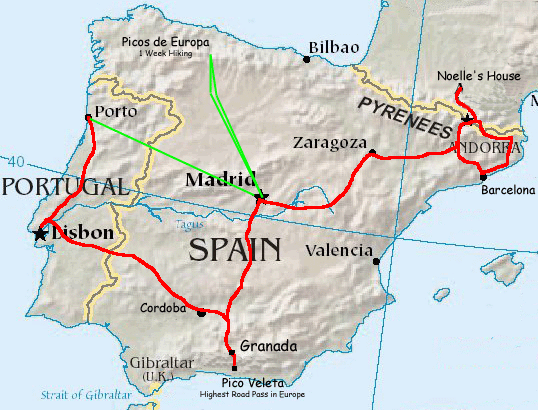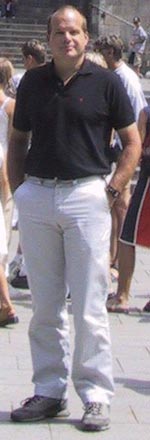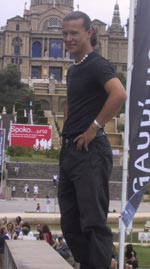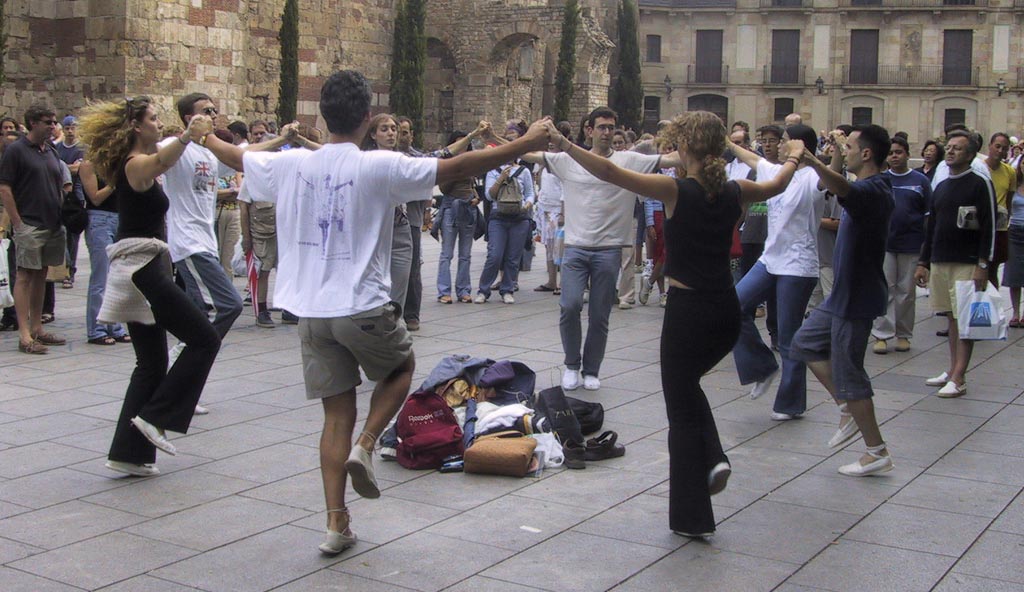
Red = Cycle 3,000 km (1,900 Miles)
I'm getting worse with the straight line thing
|

Red = Cycle 3,000 km (1,900 Miles) |
"Though we travel the world over to find the beautiful, we must carry it with us or we find it not." Ralph Waldo Emerson
I came to Spain for a couple of reasons, but they're probably not quite what you would expect. (In fact, they turned out to be not what I expected either). Etienne has been telling me to go to Spain for a year, and even made a list of great things to see. Noelle's boyfriend David told me a lot about Spain as well, and I've heard great things about it from other people I know that have visited it. I wanted to do a bit of touring in Europe, and Spain sounded more interesting than France. However, probably the biggest reason is that it was handy. Noelle lives a stone's throw from the border (well, 2 days cycling but why quibble). When I decided to visit Noelle, I was seriously considering getting a round trip and coming back to Africa, as I have lots more I want to see in Africa and I could have gotten a round trip for another 50 bucks. However, it was winter in Africa and summer in Europe, and I was in a mood for a bit of European travel, so Spain seemed like the obvious choice. I'm quite happy that I made that choice, and I'm finding Spain to be quite agreeable as a place to visit.
You can learn some facts from Lonely Planet or the CIA FactBook. Spain is 50% bigger than Vietnam or California, or double the size of Oregon or 5% the size of the US. It's population density is 3 times that of the US. Spain and Portugal are separated form the rest of Europe by the Pyrenees, which at times have prevented mixing of the population and at times hasn't. This gives the area a character that's different from the rest of Europe in some ways and the same in others. It's the only part of Europe that was conquered by the Muslims, and they controlled it for 800 years. It has the only example I've ever seen of a dictator setting up a democracy to be automatically jump-started on his death... and it worked. Spain has the most bicycle friendly drivers I've encountered anywhere in the world. As if that weren't enough, I met my wife there so it's been the best stop of this trip (oops... getting ahead of the story here).
Note! I started writing this page well over a year ago, and it's been 90% done for about six months. Some things have changed since I wrote it, but I'm writing the journey, not the destination so I'm leaving it as I originally wrote it... more or less.
Spain uses the Euro just like France, and the costs are a bit less.
I've talked before about why I like or dislike a city, and the fact that it's frequently pretty arbitrary. I liked Barcelona immediately and never found any reason to change that opinion. I'm a bit mystified about exactly why I like it, but fortunately I can live with that. I like it because I like it, and that's good enough for me.
I spent nearly all my time in Barcelona in the center of the old city. Like a lot of places in Europe, Barcelona started out as a fortified city. Eventually, the city walls became useless (after the invention of cannons), and so they were torn down and a new city was made outside the walls. In this particular case, it turned out that all this happened in a relatively prosperous time for the city, and so the "new city" was made with some thought and planning, instead of the random sprawl you frequently get. However, I didn't find the new city all that interesting. I rode through it on the way in, and it didn't seem to be a good or a bad place particularly, but I really liked the center of the city and saw no real reason to leave it.
On the first day in the city, I ran into Jose and Sanka. Hose is from Chile and Sanka is from Croatia. I was looking for a place to stay, and it happened that they rent a 4 bedroom flat and rent out two of them, and the two rentals happened to be empty. I went and stayed at their place for the week that I was in Barcelona. On about the third day I was there, Aaron (the woofer from Canada) showed up as well. He had hitchhiked down the other side of the Pyrenees through Pamplona. He managed to resist the temptation to run with the bulls, thus proving that not all young men are stupid... or at least not all the time. He stayed with me in the other room for a few days until it was time to leave.
The center of Barcelona is filled with fairly large blocks of buildings that sometimes have business on the first floor or two, and then seem to be occupied with flats above that. Competition for living space is intense, which is the reason Jose and Sanka have the big flat. They don't particularly want to be landlords, but it's nearly impossible to get a small flat at a reasonable price. They looked for months before taking the one they're in. In a lot of ways, I should hate the flats because they're a lot like the Soviet apartment blocks. I didn't particularly though. For one thing, they look a lot more attractive in general, and they seem a bit nicer inside on average. Another somewhat unusual thing, which may be quite common around the world but I haven't seen it, is that the apartments are organized around a central "Light Shaft". This means there's sort of a hole in the middle of the building going up to the sky, and all the apartments have windows on one side facing into this central area. The inhabitants hang their laundry in the central area. Most flats also have one or two windows on the other side that face the outside. I mentioned the laundry. Like in France, power dryers don't seem as common as in the U.S. I later found that most people I knew in Madrid had them, but the people I saw in Barcelona didn't. Most people just hang their laundry up and use the abundantly available, free, environmentally friendly sun to dry it. One odd thing with this arrangement is that if you leave the windows open in the central area, you can see into the windows on the other side of the shaft, since it's only about 4 meters away.
I spent the week in Barcelona FINISHING the project I've been working on since the dawn of time. I started what seemed like a relatively small project last September in Petrozovodsk. I worked on it for a month, then put it on hold while I went through South Africa. I then spent about 5 months in Cape Town getting it nearly done, then some more time at Noelle's and finally put it to bed in Barcelona. Naturally, I have another half-dozen right behind it but it's really nice to finally finish something. It's the first project I've gotten all the way through to completion since I left.
The streets in the center city are a bit strange. The blocks are mostly octagonal shaped. If you imagine a big square block, and then go chop off about 20 meters from each of the square corners, you'll have the idea. The extra street space is usually used for parking, or to give a small buffer zone for people turning. One side effect of this is that you can't just walk straight down the sidewalk. When you come to an intersection, you have to either go down about 5 meters to get to the crosswalk which is at the end of the cut-off section, or bonzai it across the middle of the street.
La Rambla is the main tourist drag in town, but it doesn't seem touristy. I ended up walking there quite a few times, and it's very busy but mostly with Spaniards; or at least it gives that impression. My first day in town I actually found it by the simple expedient of using my compass to head toward the ocean; which amounts to random chance in this case. The old city extends on either side of it. Jose and Sanka's place is near where the Jewish Quarter used to be. Spain has been the clash point between Islamic, Christian and Jewish culture for some time. Lots of big cities have places where one or the other of those groups gathered together at some time in the past, sometimes by choice and sometimes by force. In the very last occupation when the Christians defeated the Muslims, all Muslims and Jews were expelled, so the quarter isn't really Jewish anymore.
Barcelona is the capital of the Catalan region of Spain. This region is a bit different from the rest of Spain. The official language is Catalan, which is a dialect of Spanish that's different from the Castilian Spanish spoken everywhere else. Nearly everyone speaks Spanish as well. For me, I found the Catalan to be just a bit more of a problem than the rest of Spain, because they use different words for the pathetic little bit of Spanish I know -- although I later found out that the Mexican version I know is wrong everywhere else too. The culture in Catalan is reputed to be a bit more businesslike than the rest of Spain, or that's what the guidebooks claimed. I didn't find a whole lot of difference myself, but what do you expect for a week.

I bought some new duds in Barcelona, because my old ones finally got too disreputable looking for even my lax standards. My "good" shirt (I carry 3 shirts and 2 jerseys) was one a friend gave me in Saigon, so I've been wearing it for over a year. My good pants were made in Saigon. I left one pair in a hotel somewhere in Cape Town, and the others were falling apart and I was getting tired of patching them. My blue collar experience at Noelle's was the last straw from them.
Shopping was a harrowing experience. I had to go to a store, and LOOK through a whole lot of clothing and CHOOSE something to wear for the next year. I've learned one thing. If you hate shopping, and you spend a couple of years on a bike, you're likely to still hate shopping. Finding pants was the toughest part. If you went by what's in stock, you would have to assume that all Spaniard men are about 7 feet tall and weigh about half of what I do. It was kind of funny in a shopping-challenged sort of way. I found out what size I wear in European, and found some that were the right waist size but wrong length. I then started through a pile of pants looking for the right size. In Spain, they use a comma as a decimal point, and a dot for what Americans use a comma for. I went through a huge pile looking at numbers that I thought were the size, only to eventually figure out I was looking at the price. Then I had to start over again. As it worked out, I could in fact have found the pants I needed by using the price. Some interminably long period of time later when I finally found some that fit, they were American made, and therefore the most expensive pants in the store. I could have just assumed I was in for it and worked my way through price tags until I found the most expensive ones.
I went with a black shirt because my old best shirt was white. If I ride another year, maybe I'll buy one that's gray just so show that I'm not a complete extremist.
I'll have to admit now that I didn't make much of a tourist in Barcelona; or Spain in general for that matter. There are a couple of reasons for this, besides the obvious one that I'm lazy.
Spain has been a melting pot and conflict point for the three big religious groups for centuries. The Muslims first entered the Spanish Peninsula in the 8th century, then the Christians completely kicked the Muslims out in 1492, thus creating a unified Spain for the first time. As it happens, it was a woman, Isabel I the Catholic Queen, who conquered Granada, the last Muslim reign. Looking at the Alhambra, the beautiful palace that he was going to lose, The Caliph wept bitterly and she told him: "Yes, weep as a woman for what you haven't been able to defend as a man." It is said that she promised never to change her shirt until she could enter Granada. It took her ten years, but she made it. By the way, this Isabel was the same queen that financed Columbus to go and "discover" America (note: the term discover usually means make Europeans less ignorant about a place). The Jews alternately helped out one side or the other, based on the politics of the day, and they were kicked out in 1492 as well. The Muslims never managed to get over the Pyrenees into France, so Spain is the only part of Europe where the three cultures mixed and produced something new and different. It's the reason that Spanish people look different on average from the rest of the Europeans: they have Moorish blood from the time that the Muslims were here. It's also part of the reason that their culture and other things are different. One of the most noticeable Muslim influences is in their music. Flamenco and Cante Jondo are two styles of music with Muslim roots. The Spanish language also has a lot of Arabic words. The Islamic influence is stronger in the south than in the rest of Spain.
 This mixing
has two effects from a visiting perspective. The history is pretty interesting because this and
Palestine were two of the great battlegrounds between Christians and Muslims, and it produced a unique
culture. On the other hand, the end result from my perspective is that nearly every tourist attraction
is heavily tied in with religion. For instance, in Barcelona the big sites are cathedrals, La Familia
which is a big and sort of weird Christian church, religions shrines and the like. I've seen just
about enough churches for one lifetime, so I don't find them very interesting. People that are
particularly interested in architecture can use these to follow the development of architecture through the
various periods, but I'm not all that interested in that either.
This mixing
has two effects from a visiting perspective. The history is pretty interesting because this and
Palestine were two of the great battlegrounds between Christians and Muslims, and it produced a unique
culture. On the other hand, the end result from my perspective is that nearly every tourist attraction
is heavily tied in with religion. For instance, in Barcelona the big sites are cathedrals, La Familia
which is a big and sort of weird Christian church, religions shrines and the like. I've seen just
about enough churches for one lifetime, so I don't find them very interesting. People that are
particularly interested in architecture can use these to follow the development of architecture through the
various periods, but I'm not all that interested in that either.
Aaron and I went out and visited a fort one day, mainly because he'd been sleeping in the park right below it in his sleeping bag, and partly because it was interesting. Let me repeat that Aaron came here with practically no money and has been here for months. Particularly for Westerners, if you want to travel there are really not many valid excuses why you can't. (You've probably noticed I'm on a mission to get people to travel.)
On the last day, Aaron and I decided one day to go out and do our duty as good tourists. We went to La Familia, which is Barcelona Tourism personified. We stood there for about five minutes looking at it and said "Yep, that's a church all right. Let's go get a beer." That was pretty much the end of my tourist experience in Barcelona. Not only that, my camera was in the last throws of it's death rattle at that point, so there aren't a lot of photos.
All was not lost though. Barcelona does have some good museums, and I went to a couple. I quite liked them but unfortunately, all the ones I went to didn't allow cameras at all. Oddly enough, nearly all my favorite works were done between about 1860 and 1910. That doesn't necessarily mean that's my favorite era, as the museums were showing art from particular eras so I wasn't looking at art all the way through history. I would have liked to have a few of the works I saw on my wall at home (if I had one).
While I was waiting to have dinner with a friend I met in Barcelona, I managed to catch the weekly performance of the Sardana, the typical Catalan Dance. Spain has a very rich folklore. Amalia claims Spain and Russia are the countries with the richest folklores in the world. Spanish dancing is very different from one region to another, but the most spectacular and well known is Flamenco, which is about as different from this as you can get. This performance is done at the cathedral in Barcelona once a week, and the performers are obviously just people that like to dance. A band fires up the appropriate tune, people gather into whatever kind of circles they like and go at it. The arms are held up in the same position, and the entire dance is a series of fairly intricate steps while sort of bouncing up and down. I quite liked it. I went to a Flamenco later in Madrid and liked that even better (highly recommended... particularly if you go with your future wife... even if you don't know it at the time).
